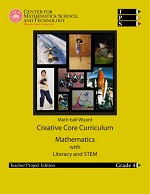Fourth Grade Mathematics

Operations and Algebraic Thinking
Plan Your Escapement
Students use tiles, fabric, or other materials to combine geometric shapes into an artistic design. Shapes can be cut in half or quarters to form other shapes and to experience fractions.
Numbers of Operations in Base Ten
Math-ball Wizard
Students design and build a pinball machine using the lid from a copy machine paper box (or similar). A tongue depressor cut in half, taped to the end of two pencils form the flippers. A ping pong ball is used. Five holes in the box are labeled with mathematical operations including minus, plus, multiply, divide, and parenthesis. There are two gates, one providing a point for each time the ball passes through. The other doubles the points. A player gets 4 balls. Each ball scores points and provides an operation.
After all four balls have been played, an equation is written using all point values twice and all operations once. A single number cannot exceed 4 digits, except in the total. For example, given a 2, 4, 7, and 9 and -, +, +, and x, an equation might be 9974 X 7 + 4 + 2 - 2 for a total score of 69,822. A data table is kept for each machine indicating the equation and high score.
Numbers and Operations - Fractions
Stomp the Math
Students make fictional insects from pipe cleaners and drinking straws. They compare measurements to actual insects. They select a song and divide beats into measures and determine the duration of the introduction, verses, chorus, etc. They calculate fractions of the song and divide it between groups. They also divide the stage into sections and give a fraction to each group.
Each group sets their insects to an opening pose and take a photo. Then they move the insects to a different pose and take another photo. One photo is taken for each beat of the music. They are all placed in a slide show and advanced at the rate of the music.
Measurement and Data
Rocket Apogee
Students use scale drawings to determine how to calculate altitude of a rocket using angle measurements and trigonometry. They launch a couple of model rockets and measure the angles. They can then determine the altitude of each rocket.
Geometry
3DGeo
Students learn about geometric shapes by constructing them using a compass and a straight edge. They then cut cardstock to the various shapes and combine them to form 3-dimensional objects much like a soccer ball and a geodesic dome.